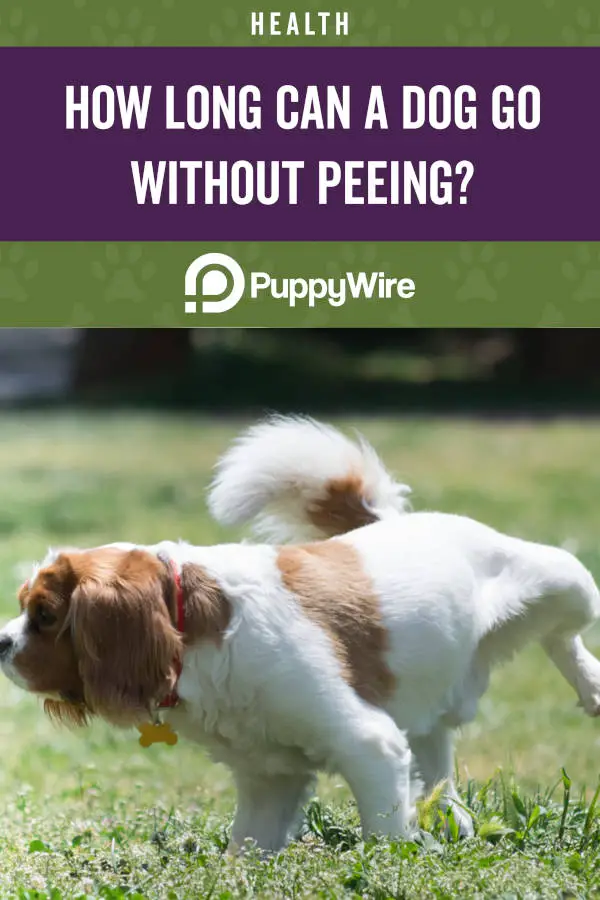How Long Can a Dog Go Without Peeing?

You may wonder how long can a dog go without peeing, and this is especially true if you work for long stretches and leave or dog alone or travel with your pet. It’s also an essential way for you to spot potential health problems with your beloved pooch if you notice that they start to go far more than they usually do.
The answer isn’t black and white, so we’ll outline the average length of time your dog can hold their pee, why it’s a good idea to let them out more often, exceptions to the general rule, and more. This way, you’ll know around how long your dog can safely refrain from having accidents, and you reduce your chances of coming how to a mess.
General Rule to Your Dog Holding Their Pee
The short answer and the general average time that a healthy dog can hold their pee ranges from six to eight hours, but they should never go longer than 10 hours at a maximum. This means that you should let them out at least three to five times a day if not more often.
There are exceptions to this rule. For example, a puppy that you’re just house training won’t hold their pee, and an older or sick dog won’t be able to hold their pee for that long either. Larger or working dogs may be able to hold their pee for 10 to 12 hours at a clip without an issue, and every dog is unique.
Puppies pee far more frequently than adults because they have smaller bladders, and the general rule of thumb is that they can hold it one hour for every month up to a year. A puppy that is six months old can realistically hold their pee for up to six hours between bathroom breaks without a problem.
What Determines How Often a Dog Has to Pee?
There are a few factors that go into deciding what is and what isn’t a healthy amount of time for your dog to hold their pee. However, the biggest factors include:
- Age – As we mentioned, puppies and older dogs won’t have as tight of control over their bladders, and you should take them out more often. A healthy middle-aged dog has better control over their bladder, and this means they can comfortably hold it longer.
- Breed/Size – Smaller breeds of dogs will have to go potty more than large breeds of dogs, so you want to get into the habit of letting them out more. One study even showed that smaller dogs are also more likely to mark certain targets when they pee, and this can lead to going more often.
- Diet – Your dog’s diet and how much they drink every day can play a role in how much they have to go potty. Expect your dog to have to go more in warmer weather because they’re drinking more in general.
- Health – Dogs that are in better health won’t have to go to the bathroom as dogs that are sick or in generally poor health. More frequent urination is actually a sign of illness, and you want to keep track of how often your dog goes because it can clue you in that something isn’t right.
- Medications – If your dog is on certain medications like diuretics or steroids, they’ll pee more because it encourages water to leave their body. Be sure to ask your vet about any side effects like increased urination when your dog starts a new medication.
- Weight – Obesity is a big problem with dogs, especially as they start to get older and not as active. An obese dog is going to have to pee more because they eat and drink more during the day. Helping your dog lose weight can help them reduce the urge to urinate as much.
Problems With Making Your Dog Hold Their Pee
Ideally, you won’t make your dog go more than six hours without going to the bathroom because this can quickly cause health problems. Once it a while won’t hurt your dog, but constantly making them wait to go out can help consequences like:
Bacteria Growth
There is a lot of bacteria in your dog’s urinary tract, and it thrives when they don’t expel it out by going to the bathroom. Constantly making your dog hold their pee can lead to a urinary tract infection or bacteria overgrowth, and this can easily make them pee a lot more until you treat it with antibiotics.
Bladder Stones
Untreated urinary tract infections can cause a crystallization of parts of your dog’s urine, and this can develop into bladder stones. If your dog can’t pass the stones, they may not be able to pee, and it may take a surgical intervention to remove them. If they pee on a normal schedule, there isn’t time for the acid to build up and form the bladder stones.
Incontinence
Urinary incontinence is a common problem in older dogs where their bladder muscles lose some of their elasticity, and they can’t hold their pee. They have to go out every few hours, and it gets worse if you try and make them hold it longer. They’ll start having accidents. If your dog is having this issue then you might check into getting an indoor dog potty to help. Check out this article to learn more.
Kidney Infections
Another serious health risk for your dog is that the bacteria from your dog’s bladder backs up into their kidneys, and this can result in a kidney infection. If you don’t catch it early and start treatment, the kidneys will eventually shut down, and your dog can die from it.
When is a Good Time to Call the Vet?
You should get in touch with your local vet if you’re worried about your dog’s bathroom habits. However, there are a few red flags that you should keep an eye out for that let you know that something isn’t right health-wise with your dog, and they are:
- Sudden increase in urination
- Several accidents
- Discomfort when they pee
- Urine is a strange color like dark red or very dark yellow
- Sudden, strong odors
- Not peeing
Addressing Sudden Accidents
If your dog starts to have accidents, it could also turn into a territorial thing where they return to the spot, again and again, to mark it as theirs. You can work on preventing peeing in the same areas of the house by soaking up as much of the urine as you can, spraying it with an enzymatic cleaner, and soaking this up with a clean cloth.
Some dogs have behavioral issues that cause them to pee when you leave them alone like anxiety. You can consult with your veterinarian or a dog trainer to see what they recommend for helping calm your dog’s anxiety or behavioral issues. Crate training, a dog walker, or doggy daycare are all viable options.
Maybe your dog was never fully housebroken or is sliding back into their old habits. Make sure you calmly correct their behavior when you catch them, clean up the area, immediately take them outside, and heap praise on them when they go out like they’re supposed to. It’s possible to teach an older dog to go outside, but it takes patience.
Bottom Line
Scheduling frequent potty breaks for your dog is vital to keeping them happy, healthy, and free of accidents. Now that you know what is a comfortable amount of time for your dog to go without going potty, you can start getting a routine in place to keep them from having accidents inside the house.
